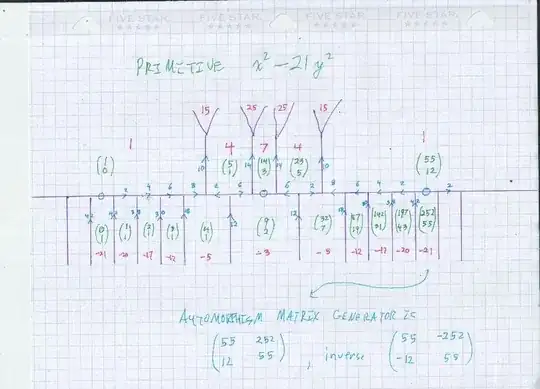This pictorial method is introduced in CONWAY and further discussed in HATCHER. There is also an intuitive book by Weissman with lots of pictures.
Here is the topograph diagram, showing solutions in a fundamental region as well as the automorphism generator. As integer column vectors, all (well, fundamental) solutions to $x^2 - 21 y^2 = 4$ are
$$
\left(
\begin{array}{c}
2 \\
0
\end{array}
\right) \; \; , \; \;
\left(
\begin{array}{c}
5 \\
1
\end{array}
\right) \; \; , \; \;
\left(
\begin{array}{c}
23 \\
5
\end{array}
\right) \; \; . \; \;
$$
For each of the three, multiply arbitrarily many times by
$$ A =
\left(
\begin{array}{cc}
55 & 252 \\
12 & 55 \\
\end{array}
\right) \; \; . \; \;
$$
The first three such vectors are
$$
\left(
\begin{array}{c}
110 \\
24
\end{array}
\right) \; \; , \; \;
\left(
\begin{array}{c}
527 \\
115
\end{array}
\right) \; \; , \; \;
\left(
\begin{array}{c}
2525 \\
551 \\
\end{array}
\right) \; \; . \; \;
$$
The next three such vectors are
$$
\left(
\begin{array}{c}
12098 \\
2640
\end{array}
\right) \; \; , \; \;
\left(
\begin{array}{c}
57965 \\
12649
\end{array}
\right) \; \; , \; \;
\left(
\begin{array}{c}
277727 \\
60605 \\
\end{array}
\right) \; \; . \; \;
$$
Put another way, if we put all such $x_n$ and $y_n$ in two ordered sequences,
$$ 2, 5, 23, 110, 527, 2525, 12098, 57965, 277727, 1330670, 6375623, 30547445, \ldots $$
$$ 0, 1, 5, 24, 115, 551, 2640, 12649, 60605, 290376, 1391275, 6665999, \ldots $$
Cayley-Hamilton tells us
$$ x_{n+6} = 110 x_{n+3} - x_n , $$
$$ y_{n+6} = 110 y_{n+3} - y_n . $$

Ummm. The continued fraction was not guaranteed to show all the solutions because 4 is larger than half the square root of 21, but this time we are lucky:
Method described by Prof. Lubin at Continued fraction of $\sqrt{67} - 4$
$$ \sqrt { 21} = 4 + \frac{ \sqrt {21} - 4 }{ 1 } $$
$$ \frac{ 1 }{ \sqrt {21} - 4 } = \frac{ \sqrt {21} + 4 }{5 } = 1 + \frac{ \sqrt {21} - 1 }{5 } $$
$$ \frac{ 5 }{ \sqrt {21} - 1 } = \frac{ \sqrt {21} + 1 }{4 } = 1 + \frac{ \sqrt {21} - 3 }{4 } $$
$$ \frac{ 4 }{ \sqrt {21} - 3 } = \frac{ \sqrt {21} + 3 }{3 } = 2 + \frac{ \sqrt {21} - 3 }{3 } $$
$$ \frac{ 3 }{ \sqrt {21} - 3 } = \frac{ \sqrt {21} + 3 }{4 } = 1 + \frac{ \sqrt {21} - 1 }{4 } $$
$$ \frac{ 4 }{ \sqrt {21} - 1 } = \frac{ \sqrt {21} + 1 }{5 } = 1 + \frac{ \sqrt {21} - 4 }{5 } $$
$$ \frac{ 5 }{ \sqrt {21} - 4 } = \frac{ \sqrt {21} + 4 }{1 } = 8 + \frac{ \sqrt {21} - 4 }{1 } $$
Simple continued fraction tableau:
$$
\begin{array}{cccccccccccccccccc}
& & 4 & & 1 & & 1 & & 2 & & 1 & & 1 & & 8 & \\
\\
\frac{ 0 }{ 1 } & \frac{ 1 }{ 0 } & & \frac{ 4 }{ 1 } & & \frac{ 5 }{ 1 } & & \frac{ 9 }{ 2 } & & \frac{ 23 }{ 5 } & & \frac{ 32 }{ 7 } & & \frac{ 55 }{ 12 } \\
\\
& 1 & & -5 & & 4 & & -3 & & 4 & & -5 & & 1
\end{array}
$$
$$
\begin{array}{cccc}
\frac{ 1 }{ 0 } & 1^2 - 21 \cdot 0^2 = 1 & \mbox{digit} & 4 \\
\frac{ 4 }{ 1 } & 4^2 - 21 \cdot 1^2 = -5 & \mbox{digit} & 1 \\
\frac{ 5 }{ 1 } & 5^2 - 21 \cdot 1^2 = 4 & \mbox{digit} & 1 \\
\frac{ 9 }{ 2 } & 9^2 - 21 \cdot 2^2 = -3 & \mbox{digit} & 2 \\
\frac{ 23 }{ 5 } & 23^2 - 21 \cdot 5^2 = 4 & \mbox{digit} & 1 \\
\frac{ 32 }{ 7 } & 32^2 - 21 \cdot 7^2 = -5 & \mbox{digit} & 1 \\
\frac{ 55 }{ 12 } & 55^2 - 21 \cdot 12^2 = 1 & \mbox{digit} & 8 \\
\end{array}
$$
After this one must still apply the automorphism matrix arbitrarily many times...
